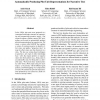Free Online Productivity Tools
i2Speak
i2Symbol
i2OCR
iTex2Img
iWeb2Print
iWeb2Shot
i2Type
iPdf2Split
iPdf2Merge
i2Bopomofo
i2Arabic
i2Style
i2Image
i2PDF
iLatex2Rtf
Sci2ools
EMNLP
2010
2010
Automatically Producing Plot Unit Representations for Narrative Text
In the 1980s, plot units were proposed as a conceptual knowledge structure for representing and summarizing narrative stories. Our research explores whether current NLP technology can be used to automatically produce plot unit representations for narrative text. We create a system called AESOP that exploits a variety of existing resources to identify affect states and applies "projection rules" to map the affect states onto the characters in a story. We also use corpus-based techniques to generate a new type of affect knowledge base: verbs that impart positive or negative states onto their patients (e.g., being eaten is an undesirable state, but being fed is a desirable state). We harvest these "patient polarity verbs" from a Web corpus using two techniques: co-occurrence with Evil/Kind Agent patterns, and bootstrapping over conjunctions of verbs. We evaluate the plot unit representations produced by our system on a small collection of Aesop's fables.
Affect States | Conceptual Knowledge Structure | EMNLP 2010 | Natural Language Processing | Plot Unit |
| Added | 11 Feb 2011 |
| Updated | 11 Feb 2011 |
| Type | Journal |
| Year | 2010 |
| Where | EMNLP |
| Authors | Amit Goyal, Ellen Riloff, Hal Daumé III |
Comments (0)

